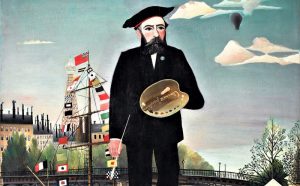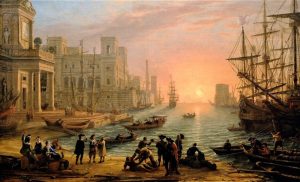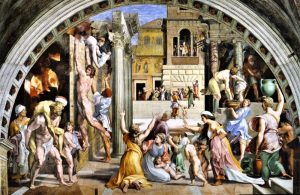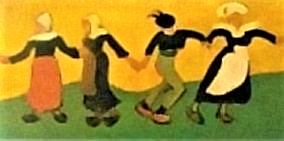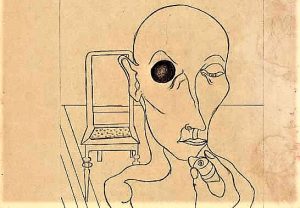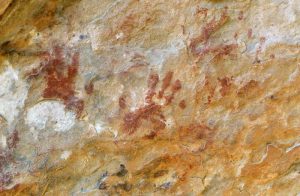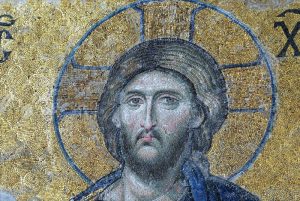Naive art
Naive art or ingenuous art as it is also known, is a work by artists in sophisticated societies who lack or reject conventional experience in representing real objects. Naive artists should not be confused with amateur artists, who paint for fun. The naive artist creates with the same passion as the trained artist, but without the formal knowledge of the methods.
What is naive art?
Naive art is a very simple, unsophisticated type of art that usually refers specifically to art made by artists who have not received formal training in an art school or academy.
Naive works are often extremely detailed, and there is a trend toward the use of bright, saturated colors rather than more subtle blends and tones. There is also a characteristic absence of perspective, which creates the illusion that figures are anchored in space, with the result that figures in naive paintings are often “floating“.
Characteristics of naive art
The main characteristics of naive art are the following:
- It presents defined contours, full of precision.
- The designs do not have an adequate finish and the strokes do not have great perspective.
- It has deficiencies in the application of colors, textures and shadows.
- It represents an ingenuous vision of the world with bright and cheerful colors.
- It has simplification of decorative elements.
- Their descriptions are quite detailed and have an idealized vision of nature.
- It presents an excellent expressive power, although the drawings tend to be incorrect.
- In the mid-20th century, most developed nations had naive artists who had achieved some prominence.
- Some painters refuse to exhibit their works for profit and paint for their families or religious institutions.
History
There are two possible ways to define when naive art originated. One is to say that it happened when naive art was first accepted as an artistic mode of equal status to any other artistic mode, and this refers to the early years of the twentieth century. The other one is to see naive art as art in itself, and to look back on human prehistory, at a time when all art was of a naive type: thousands of years ago, when the first rock drawings were engraved and when the first cave paintings of bears and other animals were made.
The first naive art, within the rural world, was inspired by the creative imagination of artisans living in a relatively autarchic environment. This art disappeared with the beginning of the Industrial Revolution, but it was later re-evaluated by the romanticism and nationalist demands of the 19th century.
Naive art of the late 19th and early 20th centuries is very different from that which existed previously and was extremely linked to urban uprooting because it longed for the idyllic nature that had been lost from a nostalgic view of the past. It sought its biblical, mythological, exotic, legendary, dreamlike and surrealistic origins.
Importance of naive art
Naive art is important for people because it captures the everyday moments that happen in people’s lives and the events that have happened in the past. It reflects the customs and celebrations in order to preserve history. It shows the realities of each town and city through the most genuine expression of the people who live that reality. It represents, in itself, the people’s history.
Naive art representatives
Many are the representatives of the naive art. Among the most outstanding representatives of this artistic movement, we can mention: the French painter Henri Rousseau, who is better known as the Customs man. After the Second World War art exhibitions increased in number in places such as Baden-Baden in 1961, Paris and Rotterdam in 1964, the itinerant exhibition of Native American artists in 1967-1968, Zurich in 1975 and the Rousseau retrospective in 1984-1985 at the Grand Palau in Paris.
The following authors are recognized in Europe:
- Aristide Caillaud in France
- Orneore Meteli in Italy
- Miguel Vivancos in Spain
- Théophilos Hadzimichael in Greece.
In the socialist countries, schools of naive painting linked to the national folklore have been developed and among the main exhibitors we have:
- Niko Pirosmanachvili in Russia
- Ivan Generalic in Yugoslavia.
In the United States, Edward Hicks was one of its most prominent representatives. In Latin America, is related to ancestral traditions, is often linked to various animist cults.
Works
Some of the main works of naive art are the following:
- The kidnapped bull (Marvilla Marrero)
- Red flower (Joan Parramon Fomos)
- Face of a councillor (Pedro Reina)
- On the roof (Isidra Ubilla Palacios)
- The Shepherd and the Boats (José Rueda)
- Field of the olive trees (C. Bentabol)
How to cite this article?
Briceño V., Gabriela. (2019). Naive art. Recovered on 3 January, 2025, de Euston96: https://www.euston96.com/en/naive-art/
